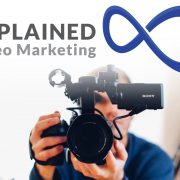Are Video Ads More Effective Than Images?
Online marketing typically scales up quickly with businesses making fast moves to capture audiences on every device. Marketing managers are now monitoring several campaigns at once, using a variety of tools to oversee bids and test creatives. So, on the topic of testing creative, which option works best: video or image ads?
One of the main issues with any creative is how much time and budget are needed to create it. The types of online ads available today are vast, as well, and digital advertisers have a lot of tools available at their disposal.
But, what makes some display ads more effective than others? And, even if you create a magnificent video ad, does it speak to your audience? Does it beat your best image-based ad?
Let’s take a look at the advantages of video and images with some statistics on why one is better than the other for different reasons.
Do Video Ads or Images Work Better Online?
You’ve probably read that videos work best to capture online engagement and conversions. Recent numbers show that 87 percent of digital marketers incorporate video content into their campaigns. The majority of internet users in the US watch videos online every day, which gives videos a better chance of being seen over a regular image ad.
But do those states make videos better than still images for display ads? Unfortunately, there are some challenges for businesses and marketers who want to utilize video. While engagement and ROI may be trending up for videos, campaigns with still images still pull a lot of reach and conversions, especially when the promotion is too good to skip past.
Here are some things to consider when comparing videos and images in advertising.
1. Images Can’t Explain It All
Videos are much better at providing information and showing customers what a product or service looks like when in use. This is a great advantage for your campaign if you have a video that conveys tons of information quickly (and cleverly) to your viewers.
Images tend to require more copy and messaging, which can become distracting and overwhelming to the eye, and people simply skip over content that they can’t consume effortlessly.
But then again, videos that aren’t produced well (or have no clear value proposition) are also problematic. Before creating videos, marketers need to think about the message and the audience.
2. More Engagement on Video Ads
Since videos automatically start to play even with the sound off on most platforms, they make a dramatic impact on your target audience. In addition, research shows that videos get the most engagement. The motion and sound of video are more captivating than anything else in a user’s feed and it instantly beats out competing content and still images.
Many customers scroll by still images because there’s no motion to engage with. To combat this lesser engagement, many marketers animate their best still image ads, which can increase reach by simply adding some minor effects.
3. Connecting to Your Audience Instantly
For newer brands or brands trying to capture a new audience, images may not say “hello” loud enough. Research shows that video advertising helps brands become thought leaders in their markets. This is because the video captures everything at once.
You can show your prospects how great a product is through a demonstration, or you can answer frequently asked questions while showing off a product. This helps you educate your customers, especially when trying to solve a problem for them. Much of advertising is just figuring out your customer’s needs and providing solutions for their common problems.
4. Build More Trust with Video
Have you ever tried marketing a product that people just didn’t understand? Maybe the product is difficult to explain, or perhaps without seeing how it works, it’s hard to believe that it will do something that the customer needs.
This is where video shines. People buy things online because they trust a brand and want something now. When you use a video to share your products and add in your brand’s personality, people see that your products are legitimate.
They get a sense of how it will work for them, and if you produce your video right, people will also trust that your brand won’t fail them. When customers feel like they understand you, they are more likely to do business with you and even pay more to get the high-quality product you’ve shown them.
5. Blow Away the Competition
You probably have seen your competitor’s ads. Are they using video? If not, you have a perfect opportunity to capitalize on their pitfalls. People gravitate to video. It allows prospects to see exactly what value they’ll get and whether your brand is trustworthy.
However, keep in mind that video content takes longer to create and publish, and you don’t want to miss the opportunity to deliver creative at the right time.
6. When Videos Aren’t a Good Idea…
There are some challenges to creating videos. They require a good script, equipment, production and creative direction. But, as with most cases, hard work almost always pays off. If you’re working with a full-service digital marketing company that knows what they’re doing, the results will be worth the (slightly longer) wait.
With all that said, images still have their place in advertising. When done right, they can be incredibly effective. Here are some instances where images still work well:
Retargeted Dynamic Image Ads
Display ads can be coded to pull image information from your website. Through remarketing and product catalogs, you can show images of viewed products to customers who have abandoned your website. Any products that they view (or even products related to those interests) can be shown later. These are called dynamic ads.
While video can certainly be used with these, it’s simply too much work to create thousands of videos for each and every product. Instead, the network will typically use the product image from your site’s URL, thus making it effortless to bring a customer back with a little incentive or promotion through a retargeting ad.
Product Carousels and Pricing
Some people just want to get the best deal on a product. When you have a highly engaged audience, showing a promotion that cuts the price of your product is a simple way to get clicks and conversions. Video ads simply aren’t necessary to show that everything in your store is half off.
However, adding animated elements (such as moving text or colors) may attract the eye more to these still images without having to spend time in a studio filming anything. These effects can be added through an animation editor like Adobe After Effects.
7. Keep Pricing in Mind
With all the additional time and effort involved in the creation and placement of video ads, you can expect them to be higher priced. If you need something more cost-effective for your bottom line, static images may be the way to go until you have the funds necessary to do video THE RIGHT WAY.
Do You Use Video or Images in Your Display Ads?
When creative draws the attention of your audience, your campaigns will shine. Both video and still images have the potential to generate leads and conversions. However, your marketing strategy may benefit from a new video ad if you haven’t tried it before.
When advertisers have good engagement but want to push the envelope, video is the best way to change it up and capture your audience’s attention even more.
Work with a full-service digital marketing agency that’s had years of experience creating effective image and video ads that result in success for their clients. Get started today with an initial consultation.











